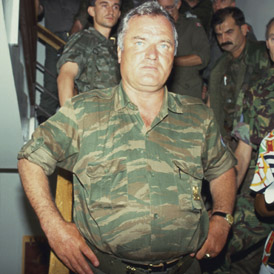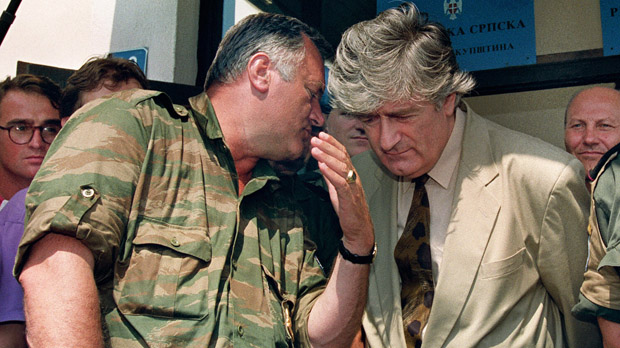Mladic war crimes trial raises questions for the West
As Ratko Mladic is finally brought before the War Crimes Tribunal in The Hague, Anthony Tucker-Jones – a former Defence Intelligence official – looks at the failures of the West in the Balkans.

After 16 years the arrest of the notorious Ratko Mladic brings back painful memories of how western policy went so badly wrong in the Balkans. Never has the adage that the road to ruin is paved with good intentions been so true.
During the early 1990s, as Yugoslavia disintegrated, the West became increasingly alarmed at the potential Islamisation of the region.
Ironically, in trying to help the Bosnian Muslims this became a self-fulfilling prophecy that ultimately distracted from the business of keeping Serb nationalists Slobodan Milosevic, Radovan Karadzic and Ratko Mladic in check.
As each republic – first Slovenia and then Croatia – slipped the rule of Belgrade, there was an increasing cycle of ethnic violence. This culminated with the war in Bosnia-Herzegovina as the Bosnian Croats, Bosnian Muslims (or Bosniaks) and Bosnian Serbs sought to stake their territorial claims.
Arming the Bosniaks
While the West tried to enforce an arms embargo against all the warring factions, American intelligence – having first secretly aided Croatia – was directed to clandestinely arm the Bosniaks.
This was achieved by making a pact with the devil – namely Iran – which, with Washington’s blessing, shipped in arms via Croatia to the Bosniaks.
With the weapons came radicals and jihadists, and the focus of western intelligence efforts became avoiding the radicalisation of the Bosnian Army holding Sarajevo.
The West became obsessed by the 3,000 jihadists, some of whom had links to al-Qaeda.

But while this was going on, the Bosnian Serbs carved out the Republika Srpska under Karadzic’s leadership, which formed a crude crescent round eastern Bosnia.
Mladic commanded the 80,000-strong Srpska Army supported by 20,000 ill-disciplined Serb militiamen.
NATO’s greatest failing was in keeping Mladic’s forces away from the Bihac pocket and the enclaves of Gorazde, Srebrenica and Zepa in eastern Bosnia.
Cruelly Operation Provide Promise, instigated by President Clinton to feed the so called “safe havens”, proved a hollow promise as the UN subsequently allowed Mladic into Srebrenica.
Cruelly Operation Provide Promise, instigated by President Clinton to feed the so called ‘safe havens’, proved a hollow promise as the UN subsequently allowed Mladic into Srebrenica.
The colonel in charge of the 600 Dutch peacekeepers at Srebrenica was under orders not to come home with any body bags. Menaced by Mladic and denied NATO air cover, he had little option but to stand back and let the Serbs have their way with the population.
Furthermore, thanks to Mladic, Sarajevo endured the longest siege in living memory (5 April 1992-12 October 1995), leaving 12,000 dead and 35,000 buildings destroyed. The presence of 1,000 UN peacekeepers at Sarajevo airport did little to alleviate the daily suffering of the population.
At the same time his forces set about the UN “safe havens” – most notably Gorazde and Srebrenica – and besieged the Bihac pocket. In the case of the latter, Britain stepped in by inserting an SAS team who called in NATO air strikes on Mladic’s troops. His forces also cooperated with the Krajina Serb Army fighting in Croatia.
Srebrenica
Fatefully Mladic’s troops entered Srebrenica on 11 July 1995 and deported 23,000 women and children. Under shellfire 15,000 men fled into the hills, and over the next five days at least half were hunted down and butchered.
It was only after news of the massacre leaked that NATO airpower was finally unleashed and, coupled with a Croat offensive, Mladic was forced to the negotiating table. Ultimately it was the Muslim-Croat alliance that prevented a complete Bosnian Serb military victory.
The 1995 Dayton Agreement unified the Bosnian-Croat Federation with the Republika Srpska. While Dayton finally brought peace it could not bring back a quarter of a million dead, nor save the 70,000 Muslims and Croats who had been driven out by Mladic.
Ultimately Karadzic, Mladic and Milosevic were not the only perpetrators of ethnic cleansing, though the Bosnian-Croat Federation got revenge; the agreement oversaw the removal of a quarter of a million Serbs from the Krajina areas of Croatia and western Bosnia.
Over the years the UN DNA-assisted identification programme has helped identify over 12,000 dead in Bosnia, half of whom are Srebrenica victims.
Their blood is on Mladic’s hands – some might argue that it is also on the West’s.
Anthony Tucker-Jones is author of “The Rise of Militant Islam” and served as the Defence Intelligence liaison officer for NATO during the Balkans crisis
-
Latest news
-
‘I violated my moral compass working for Trump,’ former lawyer testifies3m

-
Working class creatives in film and TV at lowest level in decade5m

-
Israeli police investigating attack on Gaza aid convoy4m

-
Biden announces major tariff increase on Chinese-imported green tech3m

-
‘If NHS can afford it, people with obesity should have Semaglutide,’ says weight loss expert5m

-





